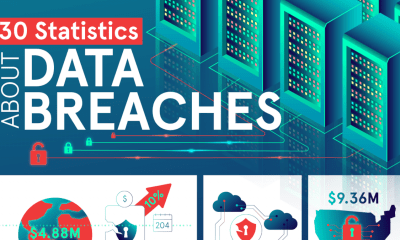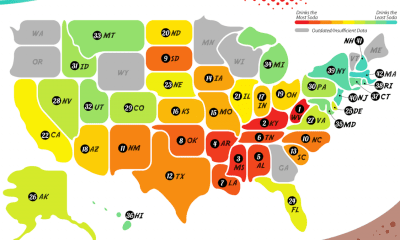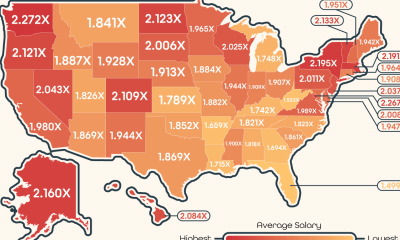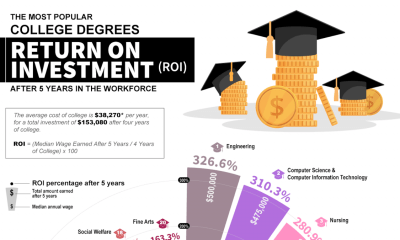Business Visualizations
Everything Owned by Apple
Apple Inc. has long been renowned for its innovation and cutting-edge contributions to technology. In the fifty years since its founding, Apple has gone from an obscure niche brand to one of the most well-known companies in the world. Throughout its history, Apple has acquired over 100 companies, some of which became core aspects of Apple’s brand. Since its inception, Apple has become nothing short of a cultural and economic phenomenon. This chart, which was created by the team at The Chartistry, takes a look at who founded Apple, the companies Apple owns, the many products they’ve created and sold throughout the years, and Apple’s largest stock holders.
Click below to zoom
A Brief History of Apple
Before it was the tech giant we know today, Apple had surprisingly humble roots. Apple Inc. was founded on April 1, 1976, by Steve Jobs and Steve Wozniak in Los Altos, California. As is legend at this point, the company was started in Jobs’ garage. There, the founders aimed to develop and sell personal computers, with a vision of changing the way the average person viewed home PCs. Their first product, the Apple I, laid the groundwork for future innovations, but it wasn’t until the Apple II’s release that they made a name for themselves with revolutionary color graphics.
After two decades competing with Microsoft in the home computer space, Apple became an unprecedented market leader in the portable MP3 space with the launch of the iPod in 2001. However, it was the creation of the iPhone in 2007 that truly elevated Apple to the great name we know today. Touted as one of the world’s most successful products, the iPhone’s many versions have sold billions of units, and allowed Apple Inc. to become the first company valued at one trillion dollars in 2018. Just two years later, it doubled that figure. Since the historic iPhone launch, Apple has released many new products to various success and increased their reach around the world through their profitable innovations and various company acquisitions.
What Companies Does Apple Own?
Since its beginnings as a home computer manufacturer, Apple has dramatically changed its operations to include a variety of products and services. Apple has acquired approximately 125 companies over its lifetime, many of which are still in operation today. Many of these were smaller companies that Apple incorporated into their products, such as FaceID being created from PrimeSense. PrimeSence was acquired by Apple in 2013.
In 2022, Apple’s CEO Tim Cook claimed Apple had acquired more than 100 companies over the preceding six years alone. Apple subsidiaries are only expected to increase as the brand continues its upward trajectory, though it’s important to note that their acquisition rate has slowed recently with the cooling of the investment in the tech sector since the start of the COVID-19 pandemic.
So far, Apple’s largest acquisition has been Beats at $3 Billion, followed by Intel at $1 Billion.
Apple’s Product Range
Currently, Apple Inc. has five main products: Macs, iPhones, iPads, accessories and services. Over the years, the company has shifted their primary focus from the home computer space in favor of the mobile device market, which has proven to be more lucrative. Though Apple has rarely been the first to introduce a product of its kind to the market, they have a history of redefining the market with their innovations to the field.
Mac
Personal computers have been the foundation of Apple’s product lineup since the beginning with Mac taking the mantle in 1979. Though they still compete with Microsoft in this space, Apple’s M1 and M2 chips have set new standards in the computing industry.
iPhone
In the era of flip phones and BlackBerry, the iPhone revolutionized the mobile phone industry and made smart phones the new global standard. Since then, each new generation of iPhone has introduced significant advancements in camera technology, processing power, and software features, solidifying its status as a market leader.
Apple Watch
The Apple Watch was introduced in 2014 and has quickly become the world’s most popular smartwatch. Combining fitness tracking, health monitoring, and communication features in a sleek, customizable design, it’s carved out a space as a health device as well as a smartphone accessory.
iCloud
iCloud, launched in 2011, is Apple’s cloud storage and computing service, which allows users to store data such as photos, documents, and music, and sync them across all their Apple devices. iCloud has become an integral part of the Apple ecosystem, ensuring seamless data management and providing services like iCloud Drive, iCloud Photos, and iCloud Backup.
Apple Pay
Apple Pay, introduced in 2014, is Apple’s mobile payment and digital wallet service. Thanks to its secure, contactless payments, integrated with the iPhone, Apple Watch, and other Apple devices, it has become a popular choice for digital transactions worldwide.
Who Owns Apple?
Apple’s stock market performance has been nothing short of remarkable. Since it first hit $1 trillion with the launch of the iPod, Apple’s continuous releases, innovations, and success have ranked it among the most valuable companies in the world. The company’s commitment to returning value to shareholders through dividends and stock buybacks further enhances its attractiveness as an investment.
As of January 2024, The Vanguard Group holds the largest percentage of Apple shares at 8.54%. Arthur Levinson, Chairman of the Board, takes the prize for individual shareholders, holding more than 4.5 million shares.
Apple Inc. is a cultural and financial juggernaut that continues to shape the modern world through its creative and strategic vision. From its humble beginnings in a garage to its status as a trillion-dollar company, Apple’s journey is a testament to its ability to adapt and lead. For investors and technology enthusiasts alike, Apple is a fascinating case study in the power of innovation and business strategy. Check out our business visualizations for more on topics like Apple, or take a look at all of the data visualizations on The Chartistry.
List of Companies Apple Owns
- Beats Electronics
- Intel Smartphone Modem Business (include S.M.D. under Intel logo)
- Dialog Semiconductor
- Anobit Technologies
- Texture
- Shazam
- NeXT
- PrimeSense
- AuthenTec
- PA Semi
- Beddit
- Braeburn Capital
- Claris
- Siri
- Mobeewave
Apple Products
| Apple Product | Percent of Company’s Revenue, end of 2023 |
| Mac | 8.00% |
| iPhone | 50%+ |
| iPad | 7.00% |
| Wearables, Home and Accessories | 10.00% |
| Airpods | |
| Apple Watch | |
| Apple TV | |
| Home Pod | |
| Vision Pro | |
| Beats Headphones | |
| Services: | 22.00% |
| App Store (advertising space) | |
| Apple News app (advertising space) | |
| AppleCare+ | |
| iCloud+ | |
| Apple Card | |
| Apple Pay | |
| Apple Books | |
| Apple Fitness+ | |
| Apple Music | |
| Apple News+ | |
| Apple TV+ | |
| Apple Arcade | |
| Apple Podcasts | |
| iTunes Store |
Who Owns Apple?
| # | The 10 Largest Stockholders | Percent of Apple Shares |
| 1 | The Vanguard Group | 8.54% |
| 2 | BlackRock | 6.75% |
| 3 | Berkshire Hathaway | 5.86% |
| 4 | State Street Corporation | 3.80% |
| 5 | Geode Capital Management | 1.95% |
| 6 | Fidelity Investments | 1.94% |
| 7 | Morgan Stanley | 1.41% |
| 8 | T. Rowe Price | 1.37% |
| 9 | Norges Bank | 1.14% |
| 10 | Northern Trust | 1.05% |
Business Visualizations
30 Statistics That Show the Alarming Reality of Data Breaches
Ooma’s new infographic shows that data breaches are a huge concern and much more common than we would like to think. Their new graphic offers 30 statistic-based facts that show us the harsh reality. Companies have limited time to react to data breaches before they hit the news cycle, and software developers have to stay on their toes to prevent security threats. Data breaches hand over customer contact details, proprietary software, and employee information to bad actors, so taking these threats seriously is of the utmost importance.
Click below to zoom.
Record High Levels of Financial Damage
The financial stakes of data breaches have never been higher. The data shows that in 2024, the average global cost of a data breach reached an all-time high of $4.88 million, a 10% increase. On average, American organizations bear the highest costs, at $9.36 million per breach. The U.S. healthcare industry is hit the hardest, with average data breach costs around $9.77 million.
Mega breaches incur the highest costs and the most damage. A mega breach involves over a million records and costs an enormous $375 million to rectify. The largest data breach was the Change Healthcare attack in February 2024, which exposed 190 million medical records and caused over $2 billion in damages. This was the largest medical data breach in American history.
Human Error Leads to Cyberattacks
55% of all data breaches are malicious attacks, with the remaining attacks split between human error and system failures. This shows that nearly half of breaches are due to internal vulnerabilities instead of being caused by the power of a sophisticated external attack. Out of all applications, Microsoft Office suffers 69.1% of cyberattacks, which means that everyday office tools can become a major target, taking advantage of employee vulnerability.
When someone inside an organization leads the attack, the expenses are highest, averaging $4.99 million. Ransomware is still a big danger, with the costs of attacks increasing by 500% between 2023 and 2024 and the average recovery cost around $2.73 million.
Delays in Detection and Containment
The amount of time it takes for organizations to detect a data breach is a bit shocking. It takes an average of 204 days to discover the breach and then another 73 days to contain it. That’s a nearly 10-month data exposure window. Most distressing is the fact that personal data breaches take the longest to detect and contain – an average of 292 days.
Recovery and Data Breach Prevention
The aftermath of a data breach remains a big challenge. Only 12% of businesses report making a full financial recovery after the breach. 70% of breached organizations have significant disruptions to business, and only 1% describe the breach as low-impact. Healthcare businesses have the longest-lasting effects with major damage to their reputation. They need to spend 79% more on marketing for the two years following a data breach. Strategic investments in cybersecurity offer stronger protection, and using AI in security operations can save around $2.2 million. Overall, this graphic emphasizes the importance of investing in strong cybersecurity.
Business Visualizations
Study Compares Small Business Owner Salaries by State
Ooma’s new study gives crucial insight into small business ownership with a map and analysis comparing average yearly salaries in every state and Washington, D.C. The study offers key insights into the world of entrepreneurship today. They used data from ZipRecruiter to create a map that systematically compares wages across the country. The team also shows that the national average annual wage across industries is $66,621, providing invaluable context for the listed salaries.
Click below to zoom.
The maps contain geographic insight into earning potential. We see Washington state in the lead with small business owners earning an impressive $144,941 a year on average. That’s an incredible 127.2% higher than the national average salaries. The team points out that the Pacific Northwest is a small business hotspot for a reason. Seattle and the Puget Sound area are hubs for innovation and technology, supported by helpful infrastructure for small businesses, plentiful coworking space, and fresh talent setting out on their own after building experience with huge companies like Google, Microsoft, and Amazon. These factors have created an environment where small businesses can not only survive but thrive thanks to low business taxes and a talented pool of entrepreneurs and employees.
The data shows that 15 states and Washington, D.C., have earning averages that are double the national average. Washington, D.C., came in second place for small business owner wages at $144,612. It’s another technology hub that enjoys the benefits of being the nation’s capital, with access to government incentives and programs that can help entrepreneurs get their ideas off the ground.
The team’s analysis didn’t look away from more challenging regions. Florida had the lowest annual salary at $95,633 a year, though, as we can see, small business owners in Florida still earn more than the national wage average. Florida is a competitive market driven by tourism, yet small business ownership is still a lucrative option here. Ooma explains that Florida business owners do face unique challenges, like a tourism market that ebbs and flows with economic changes, fewer benefits for business owners, and a high concentration of small businesses.
Apart from the pure data, we can find lots of interesting context that helps us understand regional business climates. Cost of living and market dynamics influence how much entrepreneurs can earn, and we can see facts like this visualized in the colorful map the team created. Data that could be complex becomes easy to digest and quick to reference.
Ooma did an excellent job transforming data into geographic insights that can offer people practical small business guidance. Aspiring entrepreneurs can use the data here to launch a new idea, relocate or expand successfully, while industry observers can learn new things about the small business climate. Rigorous data, practical insights, and smooth visuals combine to create an enjoyable and practical presentation of small business owner wage data.
Business Visualizations
New Study Ranks College Degrees by Return on Investment
With the high cost of college tuition making headlines, choosing a college major wisely becomes a crucial financial decision. Student Choice has analyzed college majors by their return on investment (ROI) and created a graph that ranks degrees by their ROI. Passion is certainly an important factor in choosing a college major, but knowing the ROI of a major helps prospective students plan for their future and understand their future financial prospects. This graph is a powerful tool for navigating a competitive job market.
Click below to zoom.
We can see STEM dominating the results, with an Engineering degree claiming the highest ROI at 326.6%. Computer Science earns second place with a 310.3% ROI, and Nursing has a 280.9% ROI. Student Choice gathered its data from the Bureau of Labor Statistics and compared five-year earnings to the cost of four years of college tuition. Unfortunately, Liberal Arts subjects are at the bottom of the list, although they still show a positive ROI. Education majors have a 169.8% ROI and Fine Arts have the lowest ROI at 163.3%.
The team also provided data on individual professions for which these majors qualify. The highest-paid engineers appear to be Aerospace engineers, with a whopping 427% ROI on their engineering degrees. Computer and IT Systems Managers with a degree in Computer Science have an even greater ROI, at 553.7%. Although Liberal Arts degrees have the lowest ROIs, there are still significant opportunities available in specific arts-related professions. For example, marketing managers can achieve a 511.4% ROI and earn degrees in Liberal Arts, Fine Arts, or Graphic Design to qualify. Art Directors show strong earning potential within the creative sector, with a 347.9% ROI.
Some might look at this data and conclude that they can aim for some of these careers without a four-year degree. Others might research how much more they would earn in the career path with a four-year degree. Many employers are willing to pay higher salaries to employees with higher levels of education. Some sectors offer student loan forgiveness options, which can help maximize ROI. There’s a public education loan forgiveness program that forgives student loans for teachers who work in low-income school districts for a certain length of time. Borrowers may find more flexible loan solutions from credit unions compared to federal loan systems as well. Data like this is key to helping prospective students plan for the future and achieve the best ROI.
While the data is useful and well-presented, all prospective students should consider several angles when making an important decision, like which major to declare. In addition to ROI, consider your personal instincts, financial circumstances, skills, and potential career satisfaction. While financial security is important and a strong ROI will help you secure it, job satisfaction is an important aspect of future happiness. Even so, Student Choice’s work here can help all prospective students plan for their financial future.
-

 Business Visualizations9 months ago
Business Visualizations9 months agoAmerica’s Most Valuable Companies Ranked by Profit per Employee
-
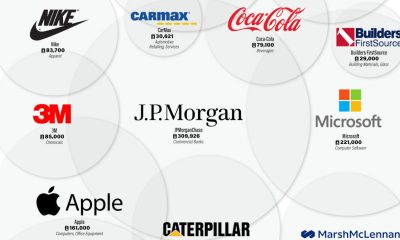
 Business Visualizations3 months ago
Business Visualizations3 months agoThe Biggest Employers by Industry
-
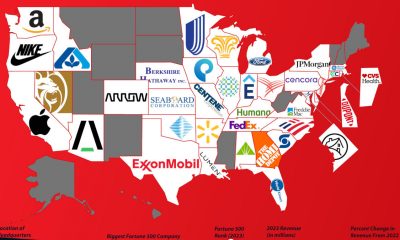
 Business Visualizations5 months ago
Business Visualizations5 months agoThe Biggest Fortune 500 Company in Every State
-
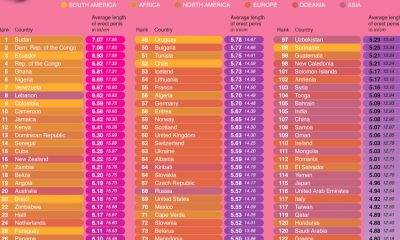
 Maps2 years ago
Maps2 years agoPenis Lengths Around the World
-

 Timelines2 years ago
Timelines2 years agoA History of the Oldest Flags in the World
-

 Charts2 years ago
Charts2 years agoThe Most Promiscuous Countries in the World
-
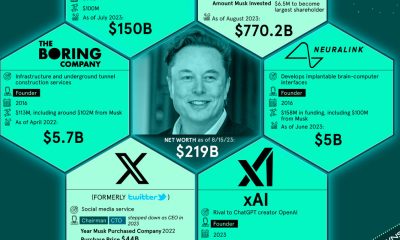
 Business Visualizations2 years ago
Business Visualizations2 years agoHow Many Companies Does Elon Musk Own?
-

 Business Visualizations1 year ago
Business Visualizations1 year agoNew Animated Map Shows Airbnb’s Fully Booked Cities Along the 2024 Eclipse Path of Totality


